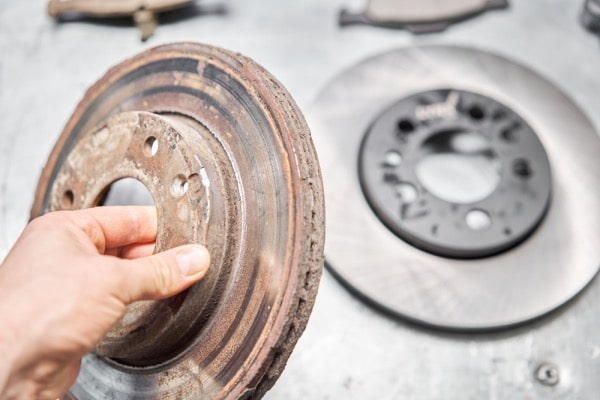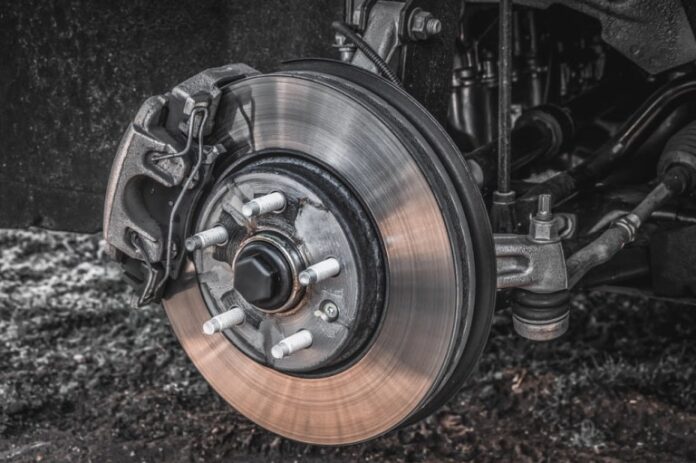Every time you engage your brakes, you’re creating friction that eats a bit of the braking pad material. Once the friction material on the pad breaks down, your car’s braking performance will drop. But how can you tell that the material is worn out? How long do brake pads last? Read on to find out the average lifespan and how you might be unintentionally wearing down your pads prematurely!
The Average Lifespan of a Brake Pad
The typical brake pad can last anywhere from 30,000 to 80,000 miles. I know this is a rather wide range, but there are lots of factors at play here, including driving style, friction material, and even traffic density. Don’t worry; I’ll go over the factors in a minute. But for now, I think we need to take a look at the warning signs. After all, it’s hard to tell whether the pads need to be replaced just by considering the lifespan range.
3 Signs That It’s Time to Change Your Brake Pads
The obvious move here is to take your car to the mechanic. They’ll check the pad’s condition. If less than a quarter of an inch of the friction material is left, then it’s time for a replacement. Visual inspections aside, there are a few telltale signs to look out for:
1. Squeaking or Grinding Noises
Turn off your car radio for a while and test your brakes. Do you hear a grinding noise? Maybe a high-pitched squeak? If so, your pads might be getting too thin.
Side Note: Not every grinding noise you hear when you hit the brake is a sign that your pads are worn out. Sometimes, a bent backing plate can be the culprit.
2. Pedals Feel Off
If you’ve been driving the same car for a while, you’ll likely feel the difference. The brake pedal will feel soft, and you’ll have to apply way more pressure just to get the car to brake properly. Unfortunately, this problem will only get worse the longer you wait!
3. Indicator Lights Are On
Check if your dashboard has a brake warning light. In this case, you’ll want to pull over and get help right away.

Factors That Affect Brake Pads’ Longevity
Some pads will need replacement after 30,000 miles or so. Others will keep going for 70,000+ miles.
Here’s why:
Driving Style, Environment, and Traffic Conditions
Did you know living in an urban area can wear down your brake pads faster? The stop-and-go driving pattern is common in cities with terrible traffic jams. Naturally, this means you’ll constantly tap the brakes during your commute, wearing down both the pads and the rotors. The same principle applies to areas with steep hills and sharp turns.
Meanwhile, people who drive mainly on highways don’t have to worry too much about stop-and-go driving. That said, sometimes the environment and traffic aren’t to blame. For one, drivers who “ride the brake” (keep one foot on the pedal at all times) need to replace their pads more often. Tailgaters, too, have to slam the brakes suddenly, which leads to premature brake pad wear. So, driving style is also an important factor here as well.

Vehicle Weight
The heavier your car is, the more effort your brake system needs to exert. That’s why folks with excessive loads in their vehicles tend to change their brake pads a lot. So, try to declutter your trunk bed and detach your trailer when you don’t need it.
Overall Condition of the Brake System
It doesn’t matter if your driving style is great—warped rotors can still wear down your brake pads pretty quickly. I recommend inspecting all the components of the braking system when you’re changing the pads. Ask the mechanic to take a look at the rotors and calipers. If they look bad, replace them while you’re at it.
Pad Material
Not all pads are created equal. Some pad materials can handle friction better than others. Take ceramic brake pads, for instance. Generally, they last long and offer smooth braking performance. But they’re on the expensive side. Organic pads, however, tend to wear out relatively fast.
Average Brake Pad Replacement Cost
How much will the pad change cost you? Well, it depends on whether you’re replacing a single axle or both. Typically, the replacement can set you back about $100–$300 per axle. Remember that you can always cut down the expenses if you DIY the replacement. However, you need a lot of experience and know-how to replace the brake pads safely.
Handy Tips to Slow Down Normal Wear and Tear on Brake Pads
There’s no way around it—you’ll have to change your brake pads at some point. However, since replacing your brake pads is expensive and often inconvenient, it’s only normal to want to delay that replacement as much as possible.

Here are some practical tips to help you do just that:
- Schedule routine inspections to check that all braking system components are in tip-top shape.
- Use a high-quality brake fluid.
- Practice smooth, gradual braking techniques.
- Don’t tailgate other cars. Leave enough space so you don’t have to slam the brakes suddenly.
Final Thoughts
In short, the lifespan estimates will vary based on the friction material type, the state of other components in the brake system, and your overall driving style. It’s safe to assume that brand-new pads will last 30,000–70,000 miles, though.
All in all, I wouldn’t wait till my car hits the 70,000-mile mark. Instead, I’d take my vehicle for routine inspections to make sure I’m not running on a faulty brake system. Remember that your own safety and the safety of others on the road are on the line here!

